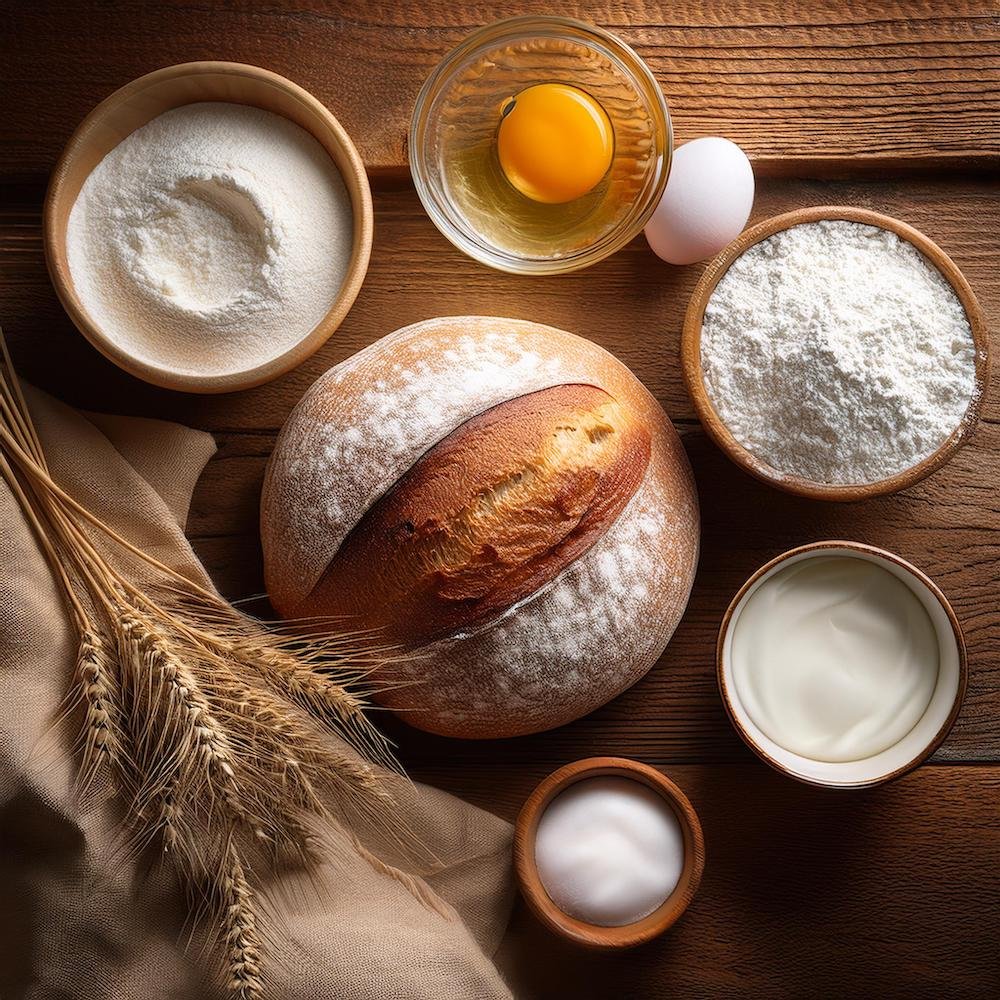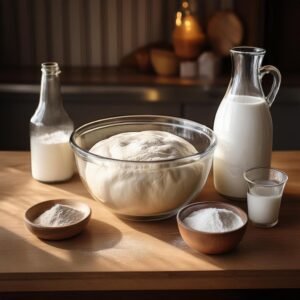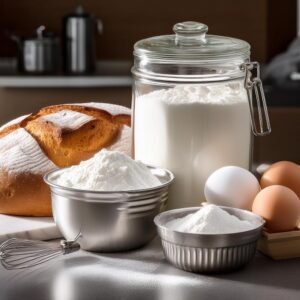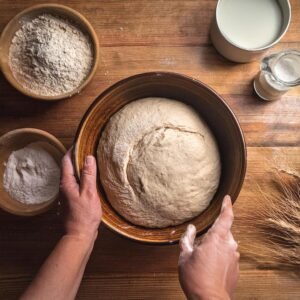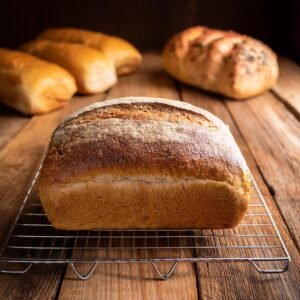What is a substitute for baking soda in bread recipe? Baking soda is a powerhouse ingredient in the world of baking, especially for bread recipes. Known scientifically as sodium bicarbonate, it works as a leavening agent, helping bread dough rise and creating a soft, airy texture. But what if you’ve started preparing your dough and suddenly realize you don’t have baking soda on hand? Don’t panic! The question “What is a substitute for baking soda in bread recipe?” has multiple answers, and with the right adjustments, your bread can still turn out perfectly.
Substituting baking soda in bread recipes involves finding alternatives that replicate its chemical properties and effects. Some substitutes, like baking powder or self-rising flour, are easy to find and use, while others, like whipped egg whites or sourdough starter, require a bit of technique. In this guide, we’ll delve into these substitutes, their applications, and how to adapt recipes for success. Whether you’re out of baking soda or want to explore new methods, this article will equip you with all the information you need to confidently bake bread without it.
Why Baking Soda Is Essential in Bread Recipes
Before diving into what is a substitute for baking soda in bread recipe, it’s crucial to understand why this ingredient is so commonly used in baking. Baking soda, or sodium bicarbonate, is more than just a leavening agent. Its chemical properties make it indispensable for achieving the right texture, flavor, and appearance in bread recipes.
Baking soda is an alkaline compound that reacts with acidic ingredients such as buttermilk, yogurt, or vinegar. This reaction produces carbon dioxide gas, forming tiny bubbles in the dough or batter. When the bread is baked, these bubbles expand, helping it rise and creating a soft, airy crumb structure. But what happens when you’re out of baking soda? Understanding its role will help you better choose what is a substitute for baking soda in bread recipe to achieve similar results.
1. Leavening: The Key to a Perfect Rise
Leavening is the primary reason why baking soda is essential in bread recipes. The carbon dioxide gas produced during its reaction with acids causes the dough to expand and rise.
-
Quick Activation: Unlike yeast, which requires time to ferment and produce gases, baking soda reacts almost immediately when mixed with an acid and exposed to heat. This makes it ideal for quick bread recipes like banana bread, cornbread, and muffins. If you’re seeking what is a substitute for baking soda in bread recipe, you’ll need to find something that mimics this quick activation process.
-
Even Texture: Baking soda ensures that the rise is uniform, giving your bread a consistent crumb structure without large air pockets.
-
Light and Fluffy Bread: Without proper leavening, bread can turn out dense and heavy. Baking soda’s ability to introduce air into the dough is what creates that light, tender texture.
2. Balancing Flavors: Neutralizing Acidity
Another critical role of baking soda is its ability to balance flavors by neutralizing acids in the recipe. Acidity can come from ingredients like buttermilk, yogurt, molasses, or even natural fruit acids (e.g., in mashed bananas).
-
Enhanced Sweetness: By neutralizing acidic components, baking soda enhances the natural sweetness of the ingredients, making the bread taste more balanced. This is an important consideration when choosing what is a substitute for baking soda in bread recipe since certain substitutes may lack this neutralizing effect.
-
Smoothing Tangy Flavors: Recipes with strong acidic components, such as buttermilk biscuits or sour cream cornbread, can taste overly tangy without baking soda to offset the acidity.
-
Improved Flavor Complexity: The alkalinity of baking soda can slightly enhance other flavors in the bread, giving it a richer taste profile.
3. Crust Development: A Golden-Brown Finish
Baking soda contributes to the bread’s appearance by promoting browning through the Maillard reaction. This is a chemical process where amino acids and sugars react under heat, creating the rich color and complex flavors associated with baked goods.
-
Golden-Brown Crust: The alkaline nature of baking soda speeds up the Maillard reaction, resulting in a beautifully browned crust.
-
Appetizing Appearance: A pale, underbaked-looking loaf can be unappealing. Baking soda helps create the golden exterior that signals a perfectly baked loaf.
-
Enhanced Aroma: The browning process also contributes to the inviting aroma of freshly baked bread, as it develops deeper, toasted notes.
When you’re searching for what is a substitute for baking soda in bread recipe, it’s important to prioritize options that can replicate these critical functions, whether through leavening power, flavor balancing, or crust development.
What Happens Without Baking Soda?
If baking soda is omitted or not properly substituted in a bread recipe, the results can be noticeably different:
- Dense and Heavy Texture: Without the gas bubbles created by baking soda, the dough won’t rise properly, resulting in a compact loaf.
- Tangy, Overpowering Flavors: The acidity in the recipe remains unchecked, making the bread taste sharper or sourer than intended.
- Pale, Unappealing Color: The lack of baking soda slows the Maillard reaction, leading to a pale crust that lacks the visual appeal of a well-baked loaf.
By understanding why baking soda is essential in bread recipes, it becomes clear why choosing the right substitute is so important. When you substitute baking soda effectively, you can still achieve a bread that rises beautifully, tastes balanced, and has a golden crust that’s sure to impress.
What Is a Substitute for Baking Soda in Bread Recipe?
Let’s look at the best options for what is a substitute for baking soda in bread recipe and how to use them effectively. These substitutes can help you achieve the desired texture and rise, even without baking soda.
1. Baking Powder: The Easiest Substitute for Baking Soda in Bread
Baking powder is a ready-made leavening agent containing both an acid (cream of tartar) and a base (baking soda). It’s the most straightforward substitute for baking soda.
- How to Use: Replace 1 teaspoon of baking soda with 3 teaspoons of baking powder.
- Why It Works: Baking powder activates on its own and doesn’t require additional acidic ingredients.
- Best For: Quick breads like cornbread, banana bread, and muffins.
- Adjustments: Reduce other acidic components in your recipe to avoid overly tangy flavors.
When wondering what is a substitute for baking soda in bread recipe, baking powder is often the first choice due to its simplicity and similar leavening properties.
2. Self-Rising Flour: An All-in-One Alternative
Self-rising flour is pre-mixed with baking powder and salt, making it a convenient substitute for baking soda.
- How to Use: Replace all-purpose flour and baking soda with self-rising flour in equal quantities.
- Why It Works: The built-in leavening agents make it easy to achieve proper rise.
- Best For: Cornbread, biscuits, and other quick breads.
- Adjustments: Reduce added salt in your recipe to balance the salt already present in self-rising flour.
Using self-rising flour is a hassle-free solution when you need to decide what is a substitute for baking soda in bread recipe.
3. Whipped Egg Whites: A Creative Substitute for Baking Soda
Whipping egg whites incorporates air into the batter, providing a leavening effect similar to baking soda.
- How to Use: Beat egg whites to stiff peaks and gently fold them into the batter. Use the whites of 2 eggs for every teaspoon of baking soda.
- Why It Works: Air bubbles expand during baking, creating a light texture.
- Best For: Pancakes, banana bread, and sponge cakes.
- Adjustments: Avoid overmixing the batter to preserve the airiness of the egg whites.
For a more natural approach to what is a substitute for baking soda in bread recipe, whipped egg whites offer both lift and texture.
4. Sourdough Starter: A Natural Substitute for Baking Soda
A sourdough starter, made from fermented flour and water, can act as a natural leavening agent in bread recipes.
- How to Use: Replace 1 teaspoon of baking soda with 1/2 cup of sourdough starter. Adjust liquids in the recipe to balance moisture.
- Why It Works: The fermentation process produces gases that help the bread rise.
- Best For: Rustic loaves, pancakes, and waffles.
- Adjustments: Sourdough starter adds a tangy flavor, so reduce other acidic ingredients.
If you’re exploring a more artisanal solution for what is a substitute for baking soda in bread recipe, sourdough starter is a great option.
5. Potassium Bicarbonate: A Sodium-Free Substitute for Baking Soda in Bread
Potassium bicarbonate is chemically similar to baking soda but contains no sodium, making it a great low-sodium alternative.
- How to Use: Replace baking soda with an equal amount of potassium bicarbonate.
- Why It Works: Provides the same leavening effect without sodium.
- Best For: Any recipe requiring baking soda.
- Adjustments: Add a pinch of salt to compensate for the lack of sodium.
For those requiring a health-conscious alternative for what is a substitute for baking soda in bread recipe, potassium bicarbonate is ideal.
How to Adjust Recipes When Using Baking Soda Substitutes
Using substitutes for baking soda in bread recipes requires careful adjustments to maintain the right balance of texture and flavor. Here’s what to keep in mind:
1. Adjust Acidic Ingredients
Some substitutes, like baking powder, already contain acid. Reduce other acidic ingredients like buttermilk or vinegar to avoid overpowering tanginess.
2. Monitor Liquid Ratios
Ingredients like sourdough starter or self-rising flour may alter the moisture content. Adjust the liquids to achieve the desired dough consistency.
3. Allow Resting Time
Some substitutes take longer to activate. Let your dough or batter rest for a few minutes before baking to ensure a proper rise.
4. Expect Minor Flavor Changes
Each substitute has unique properties that may slightly change the bread’s flavor. Taste and adjust seasonings like salt or sugar if needed.
What Happens If You Bake Without Baking Soda?
Understanding what is a substitute for baking soda in bread recipe is essential to avoid the significant changes that occur when baking without it. Baking soda is a leavening agent that plays a crucial role in ensuring your bread rises, balances flavors, and develops a golden crust. If you bake without baking soda or an appropriate substitute, the results can be disappointing. Here’s how omitting it can affect your bread:
1. Flat, Dense Bread
Without baking soda or knowing what is a substitute for baking soda in bread recipe, the bread will not rise as expected. Baking soda reacts with acidic ingredients to produce carbon dioxide gas, creating air bubbles that expand during baking. Without this process:
- The bread remains dense and heavy, lacking the light texture typical of well-leavened bread.
- You’ll end up with a compact loaf that feels flat and chewy, reducing its appeal.
2. Overly Tangy Flavors
Baking soda neutralizes the acidity in recipes, ensuring a balanced flavor. Without it:
- The acidic components of the recipe, like buttermilk or yogurt, will dominate the flavor, leading to a sharper, tangier taste.
- The natural sweetness of other ingredients might not shine through, as the acid isn’t balanced.
3. Pale Appearance
Baking soda contributes to the Maillard reaction, which gives bread its appealing golden crust. Without it:
- The bread may bake to a pale, underwhelming appearance.
- You’ll miss out on the toasted, nutty flavors that develop during browning, making the bread less flavorful overall.
By ensuring you use a suitable alternative, you can avoid these issues and bake bread that is light, flavorful, and visually appealing.
FAQs
How do I substitute baking soda in bread?
You can substitute baking soda in bread with baking powder, self-rising flour, whipped egg whites, or potassium bicarbonate. Adjust other ingredients like liquids and acids to ensure the recipe works smoothly.
What can I use if I don’t have baking soda?
If you don’t have baking soda, baking powder is the easiest substitute. Self-rising flour, whipped egg whites, and sourdough starter are also great alternatives depending on the recipe.
What happens if you don’t add baking soda to bread?
Without baking soda, your bread may not rise properly, resulting in a dense, flat texture. Acidic ingredients will remain unbalanced, leading to a tangy flavor.
What happens if you bake without baking soda?
Baking without baking soda can significantly impact the rise, flavor, and appearance of bread. Using an alternative is recommended for the best results.
Examples of Recipes Without Baking Soda
Some bread recipes naturally don’t require baking soda. Here are a few ideas to try:
- Irish Soda Bread with Baking Powder: Replace baking soda with baking powder for a fluffy texture.
- Banana Bread with Whipped Egg Whites: Incorporate whipped egg whites for a light and airy loaf.
- Flatbreads: Recipes like tortillas or naan typically don’t need baking soda.
Table of Contents
Suggested Internal Links:
- What Can I Use If I Don’t Have Baking Soda?
Offers a broader discussion of substitutes for baking soda, aligning well with the article’s focus on bread recipes. - Will Bread Rise Without Baking Soda?
Explains the science of bread rising without baking soda, complementing the article’s topic. - Banana Bread Recipe Without Baking Soda
A practical recipe example that uses a substitute for baking soda, adding actionable value for readers. - What Can I Use If I Don’t Have Baking Soda for Banana Bread?
Explores alternatives specifically for banana bread, which aligns with the general bread theme. - Is It OK to Bake Without Baking Soda?
Provides a broader perspective on baking without baking soda, enriching the discussion.
Craving more tasty recipes? Make sure to follow us on Facebook , Instagram, Pinterest, and Twitter for daily updates and kitchen inspiration!
